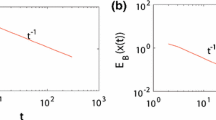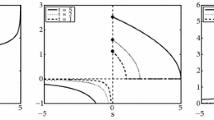Abstract
Diffusive transport in many complex systems features a crossover between anomalous diffusion at short times and normal diffusion at long times. This behavior can be mathematically modeled by cutting off (tempering) beyond a mesoscopic correlation time the power-law correlations between the increments of fractional Brownian motion. Here, we investigate such tempered fractional Brownian motion confined to a finite interval by reflecting walls. Specifically, we explore how the tempering of the long-time correlations affects the strong accumulation and depletion of particles near reflecting boundaries recently discovered for untempered fractional Brownian motion. We find that exponential tempering introduces a characteristic size for the accumulation and depletion zones but does not affect the functional form of the probability density close to the wall. In contrast, power-law tempering leads to more complex behavior that differs between the superdiffusive and subdiffusive cases.
Graphic abstract














Similar content being viewed by others
Data Availability Statement
This manuscript has no associated data or the data will not be deposited. [Authors’ comment: The data supporting the findings are available from the corresponding author upon reasonable request.]
Notes
A different type of tempering was proposed by Meerschaert and Sabzikar [54]. It leads to fundamentally different behavior and does not describe the anomalous to normal diffusion crossover. We will briefly come back to this point in the concluding section.
Naively, one might have expected a crossover between two anomalous diffusion regimes, characterized by anomalous diffusion exponent values \(\alpha \) (for times below \(t_*\)) and \(\alpha -\mu \) (for times above \(t_*\)). Because of the fragility of the anticorrelations in subdiffusive FBM, this is not the case.
References
A. Einstein, Investigations on the Theory of the Brownian Movement ( Dover, New York, 1956)
P. Langevin, C.R. Acad, Sci. Paris 146, 530 (1908)
M. von Smoluchowski, Z. Phys. Chem. 92U, 129 (1918). https://doi.org/10.1515/zpch-1918-9209
B. Hughes, Random Walks and Random Environments, Volume 1: Random Walks ( Oxford University Press, Oxford, 1995)
J.-P. Bouchaud, A. Georges, Phys. Rep. 195, 127 (1990). https://doi.org/10.1016/0370-1573(90)90099-N
R. Metzler, J. Klafter, Phys. Rep. 339, 1 (2000). https://doi.org/10.1016/S0370-1573(00)00070-3
F. Höfling , T. Franosch, Rep. Progr. Phys. 76, 046602 (2013). http://stacks.iop.org/0034-4885/76/i=4/a=046602
P.C. Bressloff, J.M. Newby, Rev. Mod. Phys. 85, 135 (2013). https://doi.org/10.1103/RevModPhys.85.135
R. Metzler, J.-H. Jeon, A.G. Cherstvy, E. Barkai, Phys. Chem. Chem. Phys. 16, 24128 (2014). https://doi.org/10.1039/C4CP03465A
Y. Meroz, I.M. Sokolov, Phys. Rep. 573, 1 (2015). https://doi.org/10.1016/j.physrep.2015.01.002
R. Metzler, J.-H. Jeon, A. Cherstvy, Biochim. Biophys. Acta 1858, 2451 (2016). https://doi.org/10.1016/j.bbamem.2016.01.022
K. Nørregaard, R. Metzler, C.M. Ritter, K. Berg-Sørensen, L.B. Oddershede, Chem. Rev. 117, 4342 (2017). https://doi.org/10.1021/acs.chemrev.6b00638
X.S. Xie, P.J. Choi, G.-W. Li, N.K. Lee, G. Lia, Annu. Rev. Biophys. 37, 417 (2008). https://doi.org/10.1146/annurev.biophys.37.092607.174640
C. Bräuchle, D.C. Lamb, J. Michaelis, Single Particle Tracking and Single Molecule Energy Transfer ( Wiley-VCH, Weinheim, 2012)
C. Manzo, M.F. Garcia-Parajo, Rep. Progr. Phys. 78, 124601 (2015). http://stacks.iop.org/0034-4885/78/i=12/a=124601
A.N. Kolmogorov, C.R. (Doklady) Acad. Sci. URSS (N.S.) 26, 115 (1940). https://mathscinet.ams.org/mathscinet-getitem?mr=MR0003441
B.B. Mandelbrot, J.W.V. Ness, SIAM Rev. 10, 422 (1968). https://doi.org/10.1137/1010093
J. Szymanski, M. Weiss, Phys. Rev. Lett. 103, 038102 (2009). https://doi.org/10.1103/PhysRevLett.103.038102
M. Magdziarz, A. Weron, K. Burnecki, J. Klafter, Phys. Rev. Lett. 103, 180602 (2009). https://doi.org/10.1103/PhysRevLett.103.180602
S.C. Weber, A.J. Spakowitz, J.A. Theriot, Phys. Rev. Lett. 104, 238102 (2010). https://doi.org/10.1103/PhysRevLett.104.238102
J.-H. Jeon, V. Tejedor, S. Burov, E. Barkai, C. Selhuber-Unkel, K. Berg-Sørensen, L. Oddershede, R. Metzler, Phys. Rev. Lett. 106, 048103 (2011). https://doi.org/10.1103/PhysRevLett.106.048103
J.-H. Jeon, H.M.-S. Monne, M. Javanainen, R. Metzler, Phys. Rev. Lett. 109, 188103 (2012). https://doi.org/10.1103/PhysRevLett.109.188103
S.M.A. Tabei, S. Burov, H.Y. Kim, A. Kuznetsov, T. Huynh, J. Jureller, L.H. Philipson, A.R. Dinner, N.F. Scherer, Proc. Nat. Acad. Sci. 110, 4911 (2013). https://doi.org/10.1073/pnas.1221962110
S. Janušonis, N. Detering, Biochimie 161, 15 (2019). https://doi.org/10.1016/j.biochi.2018.07.014
S. Janušonis, N. Detering, R. Metzler, T. Vojta, Front. Comp. Neurosci. 14, 56 (2020). https://doi.org/10.3389/fncom.2020.00056
N. Chakravarti, K. Sebastian, Chem. Phys. Lett. 267, 9 (1997). https://doi.org/10.1016/S0009-2614(97)00075-4
D. Panja, J. Stat. Mech. 2010, L02001 (2010). http://stacks.iop.org/1742-5468/2010/i=02/a=L02001
T. Mikosch, S. Resnick, H. Rootzen, A. Stegeman, Ann. Appl. Prob. 12, 23 (2002). https://doi.org/10.1214/aoap/1015961155
F. Comte, E. Renault, Math. Financ. 8, 291 (1998)
S. Rostek, R. Schöbel, Econ. Model. 30, 30 (2013). https://doi.org/10.1016/j.econmod.2012.09.003
J.-P. Kahane, Some Random Series of Functions ( Cambridge University Press, London, 1985)
A.M. Yaglom, Correlation Theory of Stationary and Related Random Functions ( Springer, Heidelberg, 1987)
J. Beran, Statistics for Long-Memory Processes ( Chapman & Hall, New York, 1994)
F. Biagini, Y. Hu, B. Øksendal, T. Zhang, Stochastic Calculus for Fractional Brownian Motion and Applications (Springer, Berlin, 2008)
S. Redner, A guide to first-passage processes (Cambridge University Press, Cambridge, 2001)
A. Hansen, T. Engøy, K.J. Måløy, Fractals 02, 527 (1994). https://doi.org/10.1142/S0218348X94000740
M. Ding, W. Yang, Phys. Rev. E 52, 207 (1995). https://doi.org/10.1103/PhysRevE.52.207
J. Krug, H. Kallabis, S.N. Majumdar, S.J. Cornell, A.J. Bray, C. Sire, Phys. Rev. E 56, 2702 (1997). https://doi.org/10.1103/PhysRevE.56.2702
G.M. Molchan, Commun. Math. Phys. 205, 97 (1999). https://doi.org/10.1007/s002200050669
J.-H. Jeon, A.V. Chechkin, R. Metzler, EPL (Europhys. Lett.) 94, 20008 (2011). https://doi.org/10.1209/0295-5075/94/20008
F. Aurzada, M.A. Lifshits, Theory Prob. Appl. 64, 490 (2019). https://doi.org/10.1137/S0040585X97T989659
C. Chatelain, Y. Kantor, M. Kardar, Phys. Rev. E 78, 021129 (2008). https://doi.org/10.1103/PhysRevE.78.021129
A. Zoia, A. Rosso, S.N. Majumdar, Phys. Rev. Lett. 102, 120602 (2009). https://doi.org/10.1103/PhysRevLett.102.120602
K.J. Wiese, S.N. Majumdar, A. Rosso, Phys. Rev. E 83, 061141 (2011). https://doi.org/10.1103/PhysRevE.83.061141
M. Delorme, K.J. Wiese, Phys. Rev. Lett. 115, 210601 (2015). https://doi.org/10.1103/PhysRevLett.115.210601
M. Delorme, K.J. Wiese, Phys. Rev. E 94, 012134 (2016). https://doi.org/10.1103/PhysRevE.94.012134
M. Arutkin, B. Walter, K.J. Wiese, Phys. Rev. E 102, 022102 (2020). https://doi.org/10.1103/PhysRevE.102.022102
T. Vojta, A. Warhover, J. Stat. Mech. 2021, 033215 (2021). https://doi.org/10.1088/1742-5468/abe700
A.H.O. Wada, T. Vojta, Phys. Rev. E 97, 020102 (2018). https://doi.org/10.1103/PhysRevE.97.020102
A.H.O. Wada, A. Warhover, T. Vojta, J. Stat. Mech. 2019, 033209 (2019). https://doi.org/10.1088/1742-5468/ab02f1
T. Guggenberger, G. Pagnini, T. Vojta, R. Metzler, New J. Phys. 21, 022002 (2019). https://doi.org/10.1088/1367-2630/ab075f
T. Vojta, S. Halladay, S. Skinner, S. Janušonis, T. Guggenberger, R. Metzler, Phys. Rev. E 102, 032108 (2020). https://doi.org/10.1103/PhysRevE.102.032108
D. Molina-Garcia, T. Sandev, H. Safdari, G. Pagnini, A. Chechkin, R. Metzler, New J. Phys. 20, 103027 (2018). https://doi.org/10.1088/1367-2630/aae4b2
M.M. Meerschaert, F. Sabzikar, Stat. Prob. Lett. 83, 2269 (2013). https://doi.org/10.1016/j.spl.2013.06.016
H. Qian, in booktitle Processes with Long-Range Correlations: Theory and Applications, editor edited by editor G. Rangarajan and editor M. Ding (Springer, Berlin, Heidelberg, 2003), pp. 22–33. https://doi.org/10.1007/3-540-44832-2_2
Y.L. Klimontovich, Statistical theory of open systems - Volume 1: A unified approach to kinetic description of processes in active systems ( Kluwer Academic Publishers, Dordrecht, 1995)
H.A. Makse, S. Havlin, M. Schwartz, H.E. Stanley, Phys. Rev. E 53, 5445 (1996). https://doi.org/10.1103/PhysRevE.53.5445
P. L’Ecuyer, Math. Comput. 68, 261 (1999). https://doi.org/10.1090/S0025-5718-99-01039-X
G. Marsaglia, Double precision RNGs, Posted to sci.math.num-analysis (2005). http://sci.tech-archive.net/Archive/sci.math.num-analysis/2005-11/msg00352.html
R. Kubo, Rep. Progr. Phys. 29, 255 (1966). https://doi.org/10.1088/0034-4885/29/1/306
T. Vojta, S. Skinner, R. Metzler, Phys. Rev. E 100, 042142 (2019). https://doi.org/10.1103/PhysRevE.100.042142
Y. Chen, X. Wang, W. Deng, J. Stat. Phys. 169, 18 (2017). https://doi.org/10.1007/s10955-017-1861-4
Acknowledgements
This work was supported in part by a Cottrell SEED award from Research Corporation and by the National Science Foundation under Grant Nos. DMR-1828489 and OAC-1919789. The simulations were performed on the Pegasus and Foundry clusters at Missouri S&T. We acknowledge helpful discussions with Ralf Metzler and Skirmantas Janusonis.
Author information
Authors and Affiliations
Contributions
T.V. conceived and coordinated the study. Z.M. and S.H. performed the computer simulations and analyzed the data. Z.M. and T.V. created the figures. T.V. wrote the manuscript.
Corresponding author
Rights and permissions
About this article
Cite this article
Vojta, T., Miller, Z. & Halladay, S. Tempered fractional Brownian motion on finite intervals. Eur. Phys. J. B 94, 208 (2021). https://doi.org/10.1140/epjb/s10051-021-00208-6
Received:
Accepted:
Published:
DOI: https://doi.org/10.1140/epjb/s10051-021-00208-6




